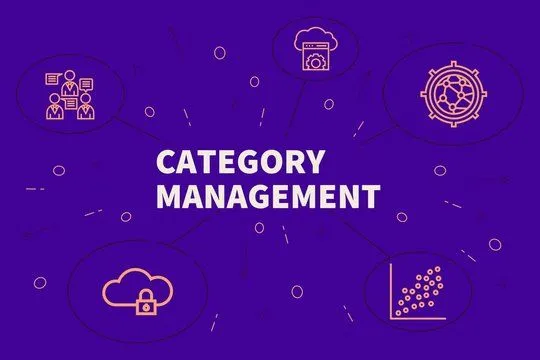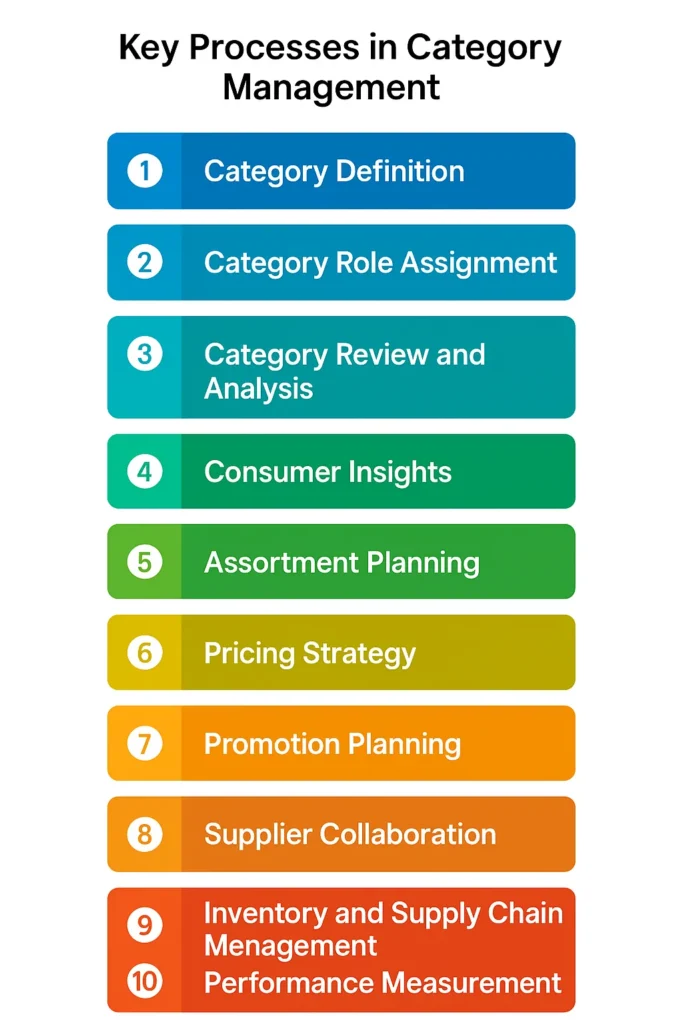
Executive Summary
Category management is a strategic approach to organizing, managing, and optimizing product categories in retail, procurement, and supply chain operations. It involves grouping products or services into logical categories, analyzing consumer behavior, supplier performance, and sales data, and developing strategies to maximize value, sales, and profitability.
This approach shifts the focus from individual products to broader categories, enabling businesses to make data-driven decisions that improve product assortment, pricing, promotions, inventory management, and supplier relationships.
Category management is widely adopted in retail, wholesale, and procurement sectors, helping organizations optimize revenue, reduce costs, and enhance customer satisfaction. This guide provides a comprehensive understanding of category management, including its processes, benefits, strategies, challenges, and real-world applications.
Table of Content
Introduction
In today’s competitive market, businesses face constant pressure to meet customer expectations while maintaining profitability. Traditional product management often focuses on individual products without considering the broader context of customer behavior, category performance, or supplier relationships.
Category management provides a structured, strategic framework that enables organizations to manage product categories holistically. By analyzing trends, sales performance, and customer preferences at the category level, businesses can develop targeted strategies to optimize assortment, pricing, promotions, and supply chain efficiency.
This approach is not limited to retail; it is also increasingly applied in procurement, manufacturing, and other industries where strategic sourcing and product grouping can drive operational excellence.
Core Concepts of Category Management
- Category Definition – Grouping products or services into logical, customer-focused categories based on function, usage, or consumer needs.
- Category Roles – Assigning strategic roles to categories, such as destination, routine, seasonal, or convenience, to guide investment and decision-making.
- Category Review and Analysis – Evaluating category performance using metrics such as sales, margin, turnover, and customer insights.
- Consumer-Centric Approach – Understanding shopper needs, behavior, and preferences to guide assortment and pricing decisions.
- Supplier Collaboration – Working closely with suppliers to optimize product range, promotions, and supply chain efficiency.
- Assortment Planning – Selecting the right mix of products within each category to maximize revenue and meet customer demand.
- Pricing Strategy – Establishing competitive pricing based on category performance, market trends, and customer expectations.
- Promotion and Marketing – Planning category-specific promotions to drive sales, traffic, and profitability.
- Inventory and Supply Chain Optimization – Ensuring the right products are available in the right quantity at the right time.
- Performance Measurement and Reporting – Using KPIs and analytics to track category performance and refine strategies.
Key Processes in Category Management

1. Category Definition
- Identify products or services that share similar characteristics or serve similar customer needs.
- Group these items into categories for strategic management.
- Example: In a grocery store, dairy products form one category, snacks another, and beverages a third.
2. Category Role Assignment
- Assign a role to each category based on its strategic importance:
- Destination Categories – Products that drive store visits (e.g., fresh produce).
- Routine Categories – Everyday items with stable demand (e.g., bread, milk).
- Seasonal Categories – Products with demand spikes during specific times (e.g., holiday decorations).
- Convenience Categories – Low-effort purchases for immediate need (e.g., snacks at checkout).
3. Category Review and Analysis
- Analyze sales data, market trends, and customer insights to evaluate category performance.
- Assess KPIs such as sales growth, margin contribution, inventory turnover, and customer satisfaction.
- Identify underperforming products and opportunities for improvement.
4. Consumer Insights
- Conduct market research, surveys, and shopper analysis to understand consumer preferences.
- Use insights to guide assortment planning, pricing decisions, and promotions.
5. Assortment Planning
- Determine the optimal mix of products within a category.
- Consider product variety, brand representation, pack sizes, and customer preferences.
- Balance availability with inventory costs and shelf space constraints.
6. Pricing Strategy
- Develop pricing strategies that maximize revenue while remaining competitive.
- Consider psychological pricing, promotional discounts, and price elasticity within each category.
7. Promotion Planning
- Design category-specific promotions to boost sales, attract new customers, and drive loyalty.
- Evaluate the effectiveness of past promotions to optimize future campaigns.
8. Supplier Collaboration
- Partner with suppliers to optimize assortment, cost, and availability.
- Negotiate favorable pricing, promotions, and joint marketing initiatives.
9. Inventory and Supply Chain Management
- Ensure products are available in sufficient quantities to meet demand.
- Monitor stock levels, lead times, and reorder points to prevent stockouts or overstocking.
10. Performance Measurement
- Track category performance using key metrics such as sales, margin, turnover, and customer satisfaction.
- Adjust strategies based on data insights and market changes.
Successful category management depends on seamless coordination between inventory systems, supplier relations, and overall resource allocation.
- To understand how organizations maintain this balance, explore Inventory Management Explained: Principles, Methods, and Future Trends — it highlights how data-driven control keeps stock aligned with demand.
- For a broader perspective on how businesses allocate people and assets efficiently, check out What Is Resource Management?.
- You can also learn how multiple categories and projects are aligned under a unified strategy in Benefits of Program Management.
Benefits of Category Management
- Improved Sales and Profitability – Focused strategies drive revenue growth and margin improvement.
- Customer-Centric Decisions – Assortment, pricing, and promotions align with consumer needs.
- Optimized Inventory – Efficient stock management reduces waste and holding costs.
- Supplier Alignment – Collaboration improves product availability, quality, and pricing.
- Data-Driven Insights – Analytics enable smarter, faster decision-making.
- Enhanced Competitive Advantage – Strategic category planning differentiates the business from competitors.
- Operational Efficiency – Streamlined processes reduce costs and resource waste.
Category Management Strategies
- Consumer-First Approach – Make decisions based on shopper behavior, preferences, and demand patterns.
- Segment-Based Strategies – Differentiate strategies for high-margin, high-volume, or niche categories.
- Cross-Functional Collaboration – Engage marketing, procurement, supply chain, and sales teams for cohesive planning.
- Data Analytics Integration – Leverage historical data, market trends, and predictive analytics for decision-making.
- Supplier Partnership Programs – Collaborate with suppliers for joint promotions, product launches, and category growth.
- Dynamic Assortment Optimization – Adjust product mix and shelf space based on real-time performance.
- Pricing and Promotion Optimization – Implement competitive pricing and targeted promotions for maximum impact.
- Performance Tracking and Continuous Improvement – Regularly monitor KPIs and refine category strategies.
Tools and Technologies in Category Management

- Retail Analytics Platforms: NielsenIQ, IRI, SPINS for consumer insights and category performance analysis.
- Category Management Software: JDA Software, Blue Yonder, Symphony RetailAI for planning and execution.
- Planogram and Shelf Optimization Tools: SmartDraw, Shelf Logic for visual merchandising and space planning.
- Data Visualization and Reporting Tools: Tableau, Power BI for tracking KPIs and trends.
- Supply Chain and Inventory Systems: SAP, Oracle NetSuite for stock management and procurement efficiency.
Challenges in Category Management
- Inconsistent data quality and availability
- Rapidly changing consumer preferences
- Managing multiple suppliers and competing priorities
- Balancing assortment, shelf space, and inventory costs
- Aligning cross-functional teams with category strategies
- Ensuring effective execution of promotions and pricing strategies
- Monitoring and adapting to market and competitor changes
Key Metrics and KPIs
- Sales Revenue per Category – Total sales generated within a category.
- Gross Margin Return on Investment (GMROI) – Profitability relative to inventory investment.
- Inventory Turnover – Frequency of stock replenishment in a category.
- Market Share – Category’s performance relative to competitors.
- Customer Satisfaction and Loyalty – Impact of category assortment and promotions on shopper behavior.
- Promotional Effectiveness – ROI from discounts, campaigns, or offers.
- Supplier Performance Metrics – On-time delivery, quality, and collaboration outcomes.
Real-World Applications
- Retail Sector – Grocery stores, fashion retailers, electronics outlets use category management to optimize assortment, pricing, and promotions.
- E-Commerce Platforms – Online marketplaces segment products into categories and tailor marketing strategies accordingly.
- Procurement and Supply Chain – Businesses organize supplier contracts and sourcing strategies by category for cost optimization.
- Consumer Packaged Goods (CPG) – Manufacturers manage product categories to align with retailer strategies and consumer demand.
- Healthcare and Pharmacy – Managing product categories to improve availability, reduce costs, and meet regulatory standards.
- Hospitality and Food Services – Menu planning, procurement, and inventory management guided by category strategies.
Common Misconceptions
- Category Management Is Only for Retail – It applies to procurement, manufacturing, and service industries as well.
- It’s Only About Grouping Products – Category management also involves analysis, strategy, pricing, promotions, and supplier collaboration.
- Data Alone Ensures Success – Effective category management requires strategy, execution, and cross-functional alignment.
- Categories Should Remain Static – Categories must adapt to evolving consumer trends and market conditions.
- It’s Only About Profit Maximization – Enhancing customer satisfaction and operational efficiency are equally important.
Future of Category Management
- AI and Machine Learning – Predictive analytics for demand forecasting, assortment optimization, and dynamic pricing.
- Omnichannel Integration – Coordinating online and offline category strategies for consistent customer experience.
- Personalization and Customer Targeting – Leveraging shopper insights for tailored product recommendations and promotions.
- Sustainability-Focused Categories – Prioritizing environmentally friendly products and ethical sourcing.
- Real-Time Analytics and Reporting – Using dashboards to make quick, data-driven decisions.
- Enhanced Supplier Collaboration – Integrating supplier data and joint strategies for category growth.
Conclusion
Category management is a strategic approach that enables businesses to optimize product categories, drive sales, and enhance customer satisfaction. By focusing on consumer needs, analyzing data, collaborating with suppliers, and implementing targeted strategies, organizations can improve profitability, streamline operations, and maintain a competitive edge.
Effective category management goes beyond product grouping—it is a holistic, data-driven discipline that aligns business objectives with consumer expectations, making it a critical component of modern retail, procurement, and supply chain management.


